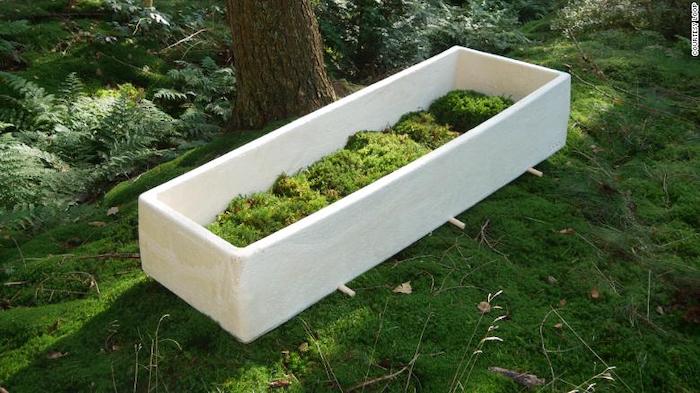— Are mushroom coffins the secret to an eco-friendly death?

by Thomas Page
Fungi are not fussy diners. Cardboard, plastic, jet fuel and asbestos — fungi will devour them all. In 2007, scientists studying Chernobyl’s blighted landscape discovered a fungus capable of “eating” radiation. It almost goes without saying, then, that fungi have little trouble decomposing us.
Dutch inventor Bob Hendrikx is harnessing the power of fungi by using mycelium — vast webs of fungal threads that normally live underground — as an alternative to traditional wooden coffins. His environmentally friendly “living coffin,” he says, is not only carbon negative to grow, but decomposes in six weeks, rather than the 20 years it can take for a regular wooden coffin. The coffin also gets to work decomposing the body, speeding up the process by which nature can absorb the nutrients of the deceased.
Hendrikx’s company Loop is not the first to hitch itself to the eco-hearse. Cremated human remains can be placed in pods to grow trees or cast into artificial coral reefs, while coffins made from wicker, macramé and cardboard are all on the market. Woodland burials, where coffins and clothing are made from all-natural materials, are also experiencing a resurgence. And when actor Luke Perry died in 2019 he was buried in a “mushroom suit” designed to help decompose his body. But using mycelium to enclose the body in a “living coffin” is a novel approach.
The motivation is simple: some funeral practices are bad for the environment. In the US alone over 4 million gallons of embalming fluid are used every year for burials, according to the non-profit Green Burial Council. Embalming fluid contains toxic ingredients such as formaldehyde, which can leach into the ground.
Cremation has its own issues, releasing considerable amounts of carbon into the atmosphere and possibly heavy metals if present in the body (the US Environmental Protection Agency calculated that nearly 2 tons of mercury, found in dental fillings, were emitted by human cremations in 2014).
“What really frustrates me is that when I die, I’m polluting the Earth. I’m waste,” says Hendrikx. He describes the body as a “walking trash bin of 219 chemicals” even before factoring in the metals, wood and glue typically used in coffins.
“Our current burial processes lead to material depletion, soil pollution and CO2 emissions,” he adds. “We created a super-industrial process for one of the most natural processes on Earth.”
But given the right treatment, the body becomes “a beautiful bag of compost.” Mushrooms, Hendrikx says, “are known as the world’s largest recycler,” turning dead organic matter into new plant life. “Why are we not using this?”
Loop’s “Living Cocoon” is comprised of lab-cultivated mycelium, woodchips and secret ingredients, placed in a mold and grown into a coffin shape over the course of a week. Once completed, moss — full of microorganisms — is packed into the bottom, onto which the body is laid. Once the structure comes in contact with damp soil the mycelium comes to life and the process begins.
Loop has partnered with biomaterials pioneers Ecovative to test the product, which Hendrikx says will decompose in 45 days. “It’s not gone,” he adds, “because it’s then working on your body.” He says calculations made by Loop with expert input indicate a corpse will fully decompose in two to three years.
The coffin, which is manufactured in Delft, is on sale for €1,495 ($1,700). Joerg Vieweg, an owner of funeral homes in Germany, is one of Hendrikx’s customers. Vieweg says the mycelium coffin is “a good example of how to achieve something ecologically with little change in the tradition of farewell.”
“(It) does not fundamentally change the process and traditions (of preparing a body for burial),” he adds, which makes burial in a mycelium coffin more socially acceptable.
To date around 100 burials have been conducted with the Living Cocoon in the Netherlands, Germany and Belgium, says Hendrikx. He says laws in some European countries are more favorable for the coffin than others. “It’s a super-conservative market,” he adds, “the same as it’s ever been.”
“The challenge at this moment is how can we convince families to organize a sustainable funeral?” she adds. “Consumers are not aware of (sustainable funeral options), because the problem is, how many times do you organize a funeral? There’s only once or twice in your life that you’re responsible.”
Van Haastert says funeral companies in the Netherlands are now training their employees to discuss climate-neutral options with bereaved families, and she hopes new legislative guidelines will be introduced for alternative funerals.
While she describes Loop’s product as “niche” at present, she speculates that “within five years (people) will ask more for these kinds of coffins.”
Hendrikx believes he’s found a positive solution, and as Loop looks to expand, it aims to create coffins using fungi samples local to their final destination to ensure they have optimal environmental impact. “Instead of doing a bad thing, or less bad thing (after death), you can actually do something good,” he says, making the case for his invention.
Vieweg believes the funeral industry is “facing a tremendous change of paradigm.”
“People are creative and look(ing) for sustainable solutions to protect our environment,” she says. “The rituals that have been lived up to now will also survive and new ones will develop. To experience this process is exciting and challenging.”
Complete Article ↪HERE↩!

